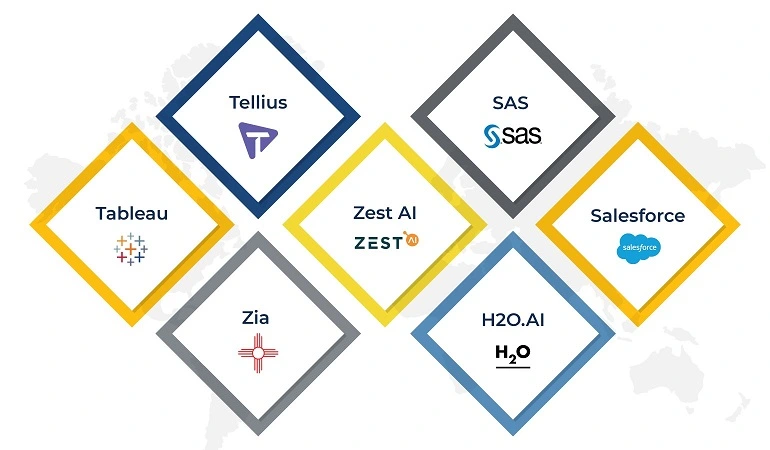Artificial intelligence is the talk of the town these days. Ideas once confined to sci-fi movies and books are fast becoming a reality now. In this digital age, AI-powered tools significantly impact how we operate as individuals and businesses. This is why over 35 percent of companies worldwide use AI tools to enhance their workflows, crunch big data, write code, publish content, and much more.
Thus, it is unsurprising that the AI market is expected to swell to a whopping $407 billion by 2027. Businesses are finding innovative ways to leverage this modern technology. And so we come to the rise of AI tools.
Yes, we all know about ChatGPT and Bard. But besides these two, there are so many fantastic AI tools out there that you can use to make your life a lot easier and your business a lot more profitable. This article explores more than 40 best AI tools you should know about in 2024.
Let’s get rolling!
Best AI Tools for Business Intelligence
-
Tableau
Tableau is one of the top data visualization tools today. It helps business executives tell their data stories through beautiful visualizations that show forecasts and enable efficient strategy-making. During the Tableau Conference 2023, company executives announced new product innovations based on generative AI that will simplify and improve analytics.
-
Tellius
As a business intelligence tool, Tellius allows users to ask questions in plain English and receive instant visualizations and insights based on their data. It is an augmented analytics platform that leverages artificial intelligence and machine learning to provide advanced analytics and insights to businesses. It offers a range of features and capabilities to help organizations explore and analyze their data, discover patterns and trends, and make data-driven decisions.
Tellius uses natural language processing (NLP) and automated machine learning (AutoML) techniques to simplify the data analysis process. It also offers advanced features like anomaly detection, time series analysis, and smart data alerts to identify unusual patterns and trends in the data.
-
Zest AI
Zest AI is an AI-powered fintech tool that uses machine learning to enable efficient, less risky, and accurate lending. It allows users to predict risk on lending options accurately and thereby safely expand their credit access. All financial institutions (banks, credit unions, savings associations, etc.) dealing with lending activities can find Zest AI helpful. It enables transparent and low-risk lending by using AI to decide instead of humans, which can be biased.
-
Zia
Zia by Zoho is an AI-powered virtual assistant that enhances productivity and efficiency in Zoho applications. It offers intelligent voice and text-based interactions to help users navigate various tasks and processes. With its advanced NLP capabilities, Zia understands user queries and provides relevant responses, insights, and recommendations.
It assists in data analysis, generating reports, scheduling activities, and streamlining workflows. Zia aims to simplify user experiences and improve decision-making by leveraging the best AI technology within the Zoho ecosystem.
-
SAS
Another business intelligence tool! Did you know that business intelligence is set to be among the most sought-after jobs in the coming years, according to the World Economic Forum? SAS is an advanced data management program that leverages open-source and cloud-enabled technologies that let companies drive their advancements and development.
It is a versatile platform that empowers businesses to handle critical operations such as risk assessment, customer intelligence, identity verification, and business forecasting. That provides companies with better and firmer control over their strategic direction. This comprehensive solution helps companies make informed decisions and propel their growth effectively.
-
AI
H2O is a fantastic AI platform recognized by Gartner as a Visionary in the 2023 Gartner Magic Quadrant for Cloud AI Developer Services. It is powered by machine learning that helps its users make data-driven decisions by providing real-time data insights. Its tools are equipped to handle various functions, such as predictive customer support and fraud detection.
Since it can handle these tasks, H2O allows users more time on their hands, which they can then spend focusing on setting and meeting strategic business issues. H2O’s website claims that H2O AI Cloud enables users to make top-notch AI models in a few minutes.
-
Salesforce
Salesforce is a leading cloud-based CRM (customer resource management) platform that uses machine learning to manage customers, sales, and development-related operations. It offers an AI assistant called Einstein AI that enables more efficient workflow by automating repeating data inputs and more intelligent business decisions through AI-generated recommendations.
Salesforce is a scalable CRM solution. Its flexibility allows businesses of all sizes to utilize the platform and its range of apps to effectively manage their customer interactions, sales processes, and other operations.
Best AI Image Manipulation/Art Generator Tools
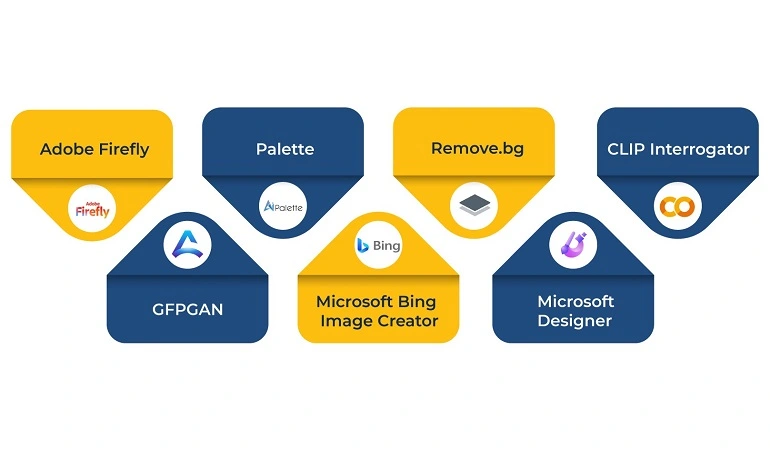
-
Adobe Firefly
Adobe’s Firefly is a fantastic image manipulation tool that uses generative AI to modify an image’s tone, color, content type, composition, and lighting. It is free to use and available on Adobe Express, Photoshop (beta), and the web. Moreover, Adobe claims it is not trained on a private dataset, making it ethical AI.
-
GFPGAN: Practical Face Restoration Algorithm
Although it is not a widely used program, GFPGAN is an amazing AI tool for blind face restoration and image freshening. In other words, this tool can restore the quality of any image. All you need to do is upload a photo, select the latest version, and select the rescaling factor. It will then give you an output: an upscaled image!
-
Palette
Do you have your grandparents’ picture in black and white and would like to see it colorized? Palette is just the right tool to do that. Unlike GFPGAN, it is not an image upscaling solution; instead, it is used to make images colorful. The palette uses advanced AI algorithms to colorize pictures within seconds.
It requires you to upload an image and give a textual explanation of what the picture is like. For instance, is it a marriage photograph or a graduation picture? You can provide the textual input saying you want twilight colors. It then renders various colorized image options from which you can choose.
-
Microsoft Bing Image Creator
Although there is a vast majority of incredible AI art generators, some don’t work well while others you need to pay for. But with MS Bing Creator, you need not be concerned with low-quality image output or fees. It is an AI art generator developed and managed by OpenAI (think ChatGPT) and is completely free to use. Give it an image prompt in text form and it will give you an output in no time.
-
bg
Remove.bg has been around for some time, and it stands for removing the background. It is free to use and allows users to remove backgrounds in images quickly. This is a particularly useful tool for graphic designers, helping them slash their editing time. You can remove the background from any image.
-
Microsoft Designer
Stunning designs in a flash! Well, yes. That is Microsoft Designer’s tagline. It empowers users to create visually stunning and professional designs. It gives you a wide range of templates, fonts, graphics, and formatting options to choose from. You can then use these for projects like presentations, brochures, flyers, etc.
It also offers a user-friendly interface and seamless integration across the Microsoft suite of applications. Microsoft Designer is an excellent AI tool that makes designing an efficient and cohesive process.
-
CLIP Interrogator
CLIP Interrogator is a remarkable image manipulation tool that delves deep into the essence of an image, emphasizing its origins rather than its visual appearance alone. It is instrumental if you’re somebody already familiar with or learning how to use Midjourney.
The CLIP Interrogator tool takes an image as input and generates prompts that can be used to recreate it. It is an effective tool across various image types, including realistic artworks. However, it would help if you remembered that it takes time due to its intricate nature, requiring patience and attention to detail. Nonetheless, for those willing to invest their time, the CLIP Interrogator holds the potential to unlock new dimensions of artistic exploration and expression.
-
PhotoADKing
For those needing high-quality, professional designs tailored to various marketing needs, PhotoADKing is an exceptional tool. Specializing in creating AI-powered flyers, posters, and logos, it offers a wide range of flyer templates for business, event, and party flyers. With PhotoADKing, you can effortlessly create stunning marketing materials without any design skills, saving time while maintaining your brand’s identity. The user-friendly interface and customizable options make your marketing campaigns effective and visually appealing.
Top AI Tools for Online Learning
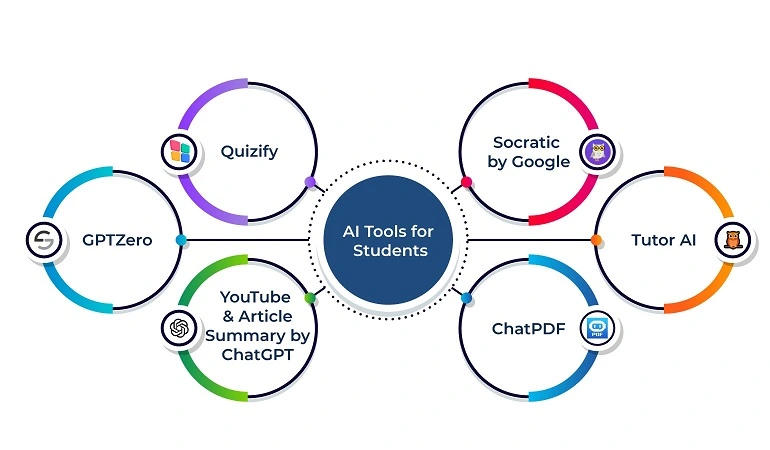
-
Socratic by Google
Children often need help with their homework. However, for parents and students alike, doing homework manually by typing questions and then getting answers can be an uphill and time-consuming task. Socratic is an AI-powered OCR (optical character recognition) tool developed by Google AI that enables you to do this visually, thus reducing the time to do the homework.
Students can click on their homework images, and Socratic will help them with the answers. It supports various subjects, including Math, Science, Social Studies, Literature, etc.
-
Tutor AI
E-learning became popular in the wake of the COVID-19 pandemic. Distance learning through the internet became the norm as schools, cities, and countries went into lockdown. Although the pandemic has primarily receded, teleschooling is still in vogue.
Tutor AI is one such platform that enables students to find relevant courses online. Although many other such platforms exist, like Coursera and Udemy, Tutor AI is free. It can also create module-based full-scale courses on a given topic. Just give it a prompt, and it will deliver a course you can read and keep for free.
-
ChatPDF
You probably already know about ChatPDF, but we think it merits a position on our list. That’s because it’s a unique tool that allows you to chat with your PDF and ask questions about its contents. The cool thing about ChatPDF is that it can handle academic, long-form research papers and documents and answers correctly. If a piece of information is missing from the document, ChatPDF does not generate a response, thus making it accurate.
-
Quizify
While Tutor AI empowers you with full-scale courses, Quizify develops—you guessed it right—quizzes! It generates quizzes using a range of sources, such as blogs, papers, articles, topics, etc. Tutor AI claims to revolutionize the learning experience through its pedagogical approach, which is bolstered by gamification.
-
GPTZero
With the rise of generative AI tools based on large language models that mimic human speech, it has become challenging for people to tell what’s been written by humans and what by AI. However, this challenge has allowed artificial intelligence companies to develop AI content checkers.
GPTZero is a tool that utilizes collected data to analyze a text’s complexity and burstiness. This helps it distinguish between AI-generated text and human-generated text. You can use it to analyze all kinds of texts; it even lets you upload files for analysis. Make an account on GPTZero, and it will check up to 5000 characters for AI plagiarism for you.
-
YouTube & Article Summary by ChatGPT
Online content exists in many forms—images, text, videos, audio, etc. So far, we have discussed image manipulation and text-based AI tools, but what about the most consumed form of content—video?
YouTube & Article Summary by ChatGPT is an excellent Chrome extension that allows you to extract the full transcript of any YouTube video and then utilize ChatGPT to automatically generate a concise and informative summary with a simple button click. It’s great for users who want to quickly skim through what the video is all about without having to watch it.
Leading AI Tools for Software Developers
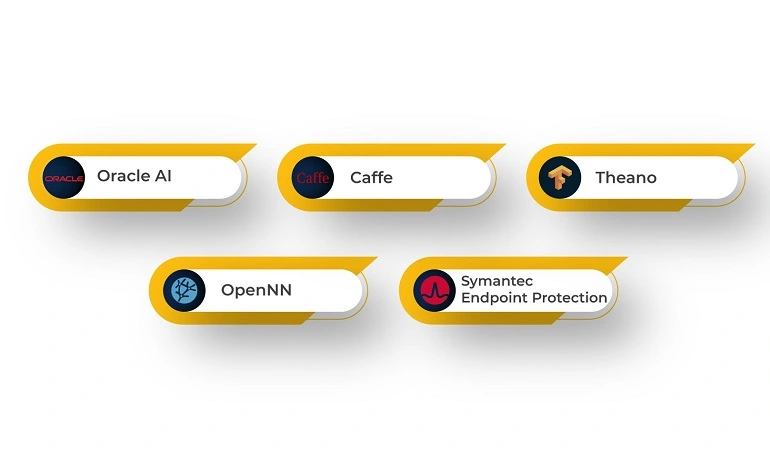
-
Oracle AI
Oracle AI is a comprehensive suite of artificial intelligence (AI) technologies and solutions offered by Oracle. The company has specifically designed it to address the needs of developers and engineers. With a focus on driving innovation and transforming businesses, Oracle AI empowers organizations to leverage the power of AI for various applications.
It provides advanced capabilities such as machine learning, natural language processing, computer vision, and predictive analytics. It can also pull open-source datasets, thus eliminating the need for developers to build software programs from scratch.
-
Caffe
Berkeley AI Research and community contributors have developed Caffe for coders and software developers. It is a deep learning framework that allows users to define, develop, and deploy software programs quickly. It is an excellent choice for researchers, startups, and corporations wishing to develop and deploy digital products. Moreover, you can integrate it with Python to refine code models and fix bugs.
-
Theano
Theano is an AI-driven library designed for Python. It allows coders and developers to build, optimize, and deploy code projects successfully. Owing to its machine-learning capabilities, Theano is incredibly good at diagnosing and resolving bugs and system malfunctions with little human support.
-
OpenNN
OpenNN (Open Neural Networks Library) is an open-source software library written in C++ designed to facilitate the implementation and training of neural networks. OpenNN provides a comprehensive set of functions and tools for developing artificial neural networks and deep learning models.
It supports different types of neural network architectures (such as feedforward and recurrent networks), various training algorithms (like backpropagation and genetic algorithms), and data preprocessing and postprocessing options. The library is designed to be flexible and customizable, allowing users to adapt and configure neural networks according to their specific needs.
-
Symantec Endpoint Protection
The rise of AI has made hacking a much more complex problem. As a result, cybersecurity has become an overarching concern for businesses everywhere. Symantec Endpoint Protection is a fantastic tool that helps companies adequately secure their digital assets using machine learning (ML).
As with other ML-powered solutions, Symantec Endpoint Protection can learn over time and, therefore, discern, with increasing accuracy, the difference between malicious and good files. Symantec claims its solution reduces users’ need to update and configure software, thus saving precious resources. It automates these tasks, and with each new threat, it improves its malware-combating capabilities.
Top AI Tools for Writing/Research/Content Generation
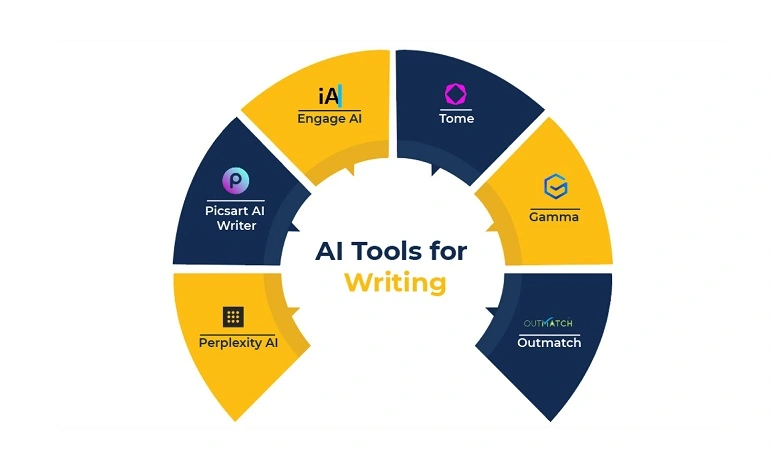
-
Perplexity AI
Perplexity AI is an answer engine that uses large language models and search engines to answer user questions accurately. As a chatbot, it uses natural language processing (NLP) and machine learning (ML) to respond to user queries. OpenAI’s GPT-3.5 and Microsoft Bing power it.
Perhaps the most distinguishing feature of Perplexity AI is that it cites its sources when answering queries. But just like other generative AI tools like ChatGPT and Bard, Perplexity also does not claim a hundred percent accuracy in its responses.
-
Picsart AI Writer
Picsart is another incredible AI solution that gives users various features like writing product descriptions, summaries, webpage copy, LinkedIn headlines, etc. It also offers an Ad copy generator, Instagram caption, email writer, and landing page outline. Just give it your query, and Picsart will oblige with every type of content.
-
Engage AI
Engage AI is a Chrome extension designed to enable LinkedIn users to write engaging, memorable, and insightful comments to increase their social engagement and build meaningful relationships with other professionals. And it’s free!
-
Tome
Here comes a storytelling tool that creates visually appealing presentations for its users! Tome has been around for some time and claims to be a “generative storytelling” AI-powered tool. It can generate text and images, allowing users to tell compelling stories about their ideas.
You need to type a prompt into its command bar, and Tome will give you a presentation and an outline. It uses DALLE.E to develop eight-slide presentations that users can edit to align with their objectives. You can use more prompts to add additional pages with deeper context.
-
Gamma
Gamma App is another exciting AI tool you should consider adding to your arsenal of AI-enabled solutions. If Tome seems challenging, this is the next best alternative, as it allows you to create equally cool presentation decks based on user prompts.
You can even create delightful web pages and organize documents using Gamma’s AI generator. Gamma also lets you share your work through online presentations with its present mode and offers its nested cards to add more information to your content. This enables efficient collaboration – not to mention that you can share your work on any device – mobile, tablet, or phone!
-
Outmatch
Outmatch is a one-stop AI-enabled recruiting solution that allows recruiters to streamline their workflow through automated interview scheduling, reference checks, and candidates’ cognitive assessment. As a result, companies using Outmatch can save significant time and resources by using this centralized solution to hire talented resources. Outmatch claims that its clients save 40 percent on their recruitment costs. That’s a lot!
-
Kickresume
Many people find it challenging to build a resume that attracts the employer’s attention. Kickresume is a powerful AI-driven tool that allows users to create visually appealing resumes. It also offers customizable templates and makes the entire resume-building process much more manageable.
Guided by OpenAI’s GPT-4 large language model, Kickresume lets you create a detailed resume that enables you to showcase your top skills and highlight your experience in the best possible manner. All it requires you to do is enter your details, and it will give you a summary with pointers.
-
Editpad
Editpad is a website offering several AI-powered writing tools that can assist writers in a number of ways. Some of its popular content generation tools include AI Paragraph Generator, Email Writer, Story Generator, and Sentence Generator. All of these tools help produce engaging and impactful content.
Beyond content creation, Editpad also offers tools such as Paraphrasing Tool and Text Summarizer that can help refine and improve your content. Moreover, its Plagiarism Checker and Grammar Checker help ensure your work is both unique and error-free.
So, whether you’re a digital marketer, blogger, or a writer, Editpad is an inclusive choice that can meet your specific writing needs. Accessing and using any of its tools is free and quick. It also has premium plans to cater to users with enterprise-level needs.
Best AI Tools for Audio
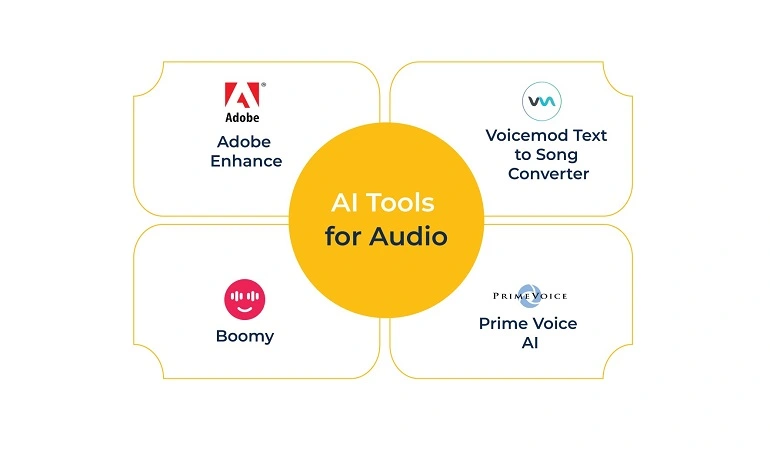
-
Adobe Enhance
Do you like to record audio? You may be a student who has to use a phone to record audio to play as a voice-over for a short video. Guess what? Adobe Enhance will make your audio sound as if you recorded it in a professional studio! It removes background noise from the audio, giving you a high-quality sound. And don’t forget, you can refine audio files for up to three hours a day for free!
-
Voicemod Text to Song Converter
Voicemod is different from other AI audio tools; instead of refining sound quality, It can create songs for you using user input.
It offers sixteen different song types based on various genres and lets you choose from seven AI singers. Choose a song type, a singer, and give your lyrics to Voicemod to get your song sung in a matter of seconds!
-
Boomy
You may have encountered several YouTube channels incorporating various freely available audio in their videos. If you’ve been searching for a similar solution, Boomy is an excellent choice.
Boomy is an AI-powered tool that offers various music genres, such as EDM, Global Groove, Rap Beats, and Lo-Fi. All you need to do is select the genre and mood and then just wait. In a few minutes, Boomy will generate a song that you can customize with Dolby Remastering and add your audio to make it even better!
-
Prime Voice AI
Have you encountered social media posts with voice samples of famous celebrities saying weird stuff? That’s not them; it’s an AI tool! Prime Voice AI is a text-to-speech and voice cloning software developed by ElevenLabs. It is a fantastic storytelling tool that lets you create rich and realistic lifelike voices.
Prime Voice AI is a speech synthesizer. It offers a collection of pre-recorded voice models and a feature to create your own model.
Best Free AI Tools for Chatting
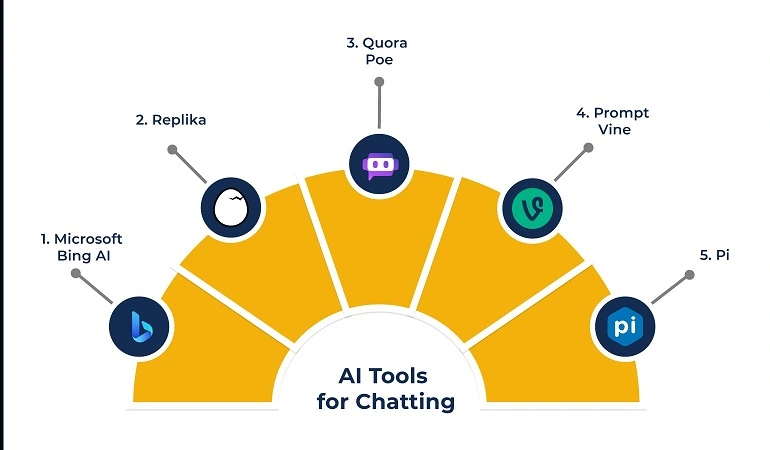
-
Microsoft Bing AI
We have purposely omitted Google Bard and ChatGPT from this list. However, Microsoft’s AI chatbot is fast catching up with these two, even though it has yet to garner the same attention. Since Microsoft is in a multiyear partnership with OpenAI, Microsoft Bing AI is powered by the powerful GPT-4 model. As a result, it can do pretty much everything that Bard and ChatGPT do. It can even generate images through the MS Bing AI Image Creator.
-
Replika
Replika has been around longer than ChatGPT or Bard. It is based on the GPT-3 large language model (LLM), a predecessor of GPT-4, and uses scripted dialogue content. Unlike the other generative AI LLM, Replika is a chatbot geared towards offering virtual companionship.
You can start chatting with it as a stranger, and the bot will learn about you and get better at having deep conversations with you. People use it to identify with someone in lonely times—it even allows video calls and a journal where your Replika records your emotions and feelings.
-
Quora Poe
Most of these AI tools are based on distinct websites. But if you want all the chatbots in one place, Quora Poe is the tool you should be looking for. You can use ChatGPT, Claude+, and other large language models using Poe.
-
Prompt Vine
Here’s another fantastic chatbot for you to consider! Prompt Vine is a community-managed collection of the top ChatGPT prompts, classified according to category, use case, or profession. In other words, you can consider it an online library for chatbot prompts. You can even become a contributor to add your favorite prompts.
-
Pi
Many AI chatbots, especially the free ones, don’t focus on the user’s mental health or provide a high-quality conversation. But Pi is different. Developed by Inflection AI, Pi is a conversational AI that can chat about various topics, answer questions, and even give advice. It is exceptionally good at understanding the context of the input.
However, unlike ChatGPT and other AI tools, Pi cannot write code or surf the internet. Nonetheless, it does provide generic solutions and talks about your problems in a friendly manner. One shortcoming is that it does not allow for a running conversation format, which can sometimes confuse the user about what was said earlier.
AI Tools For Fun
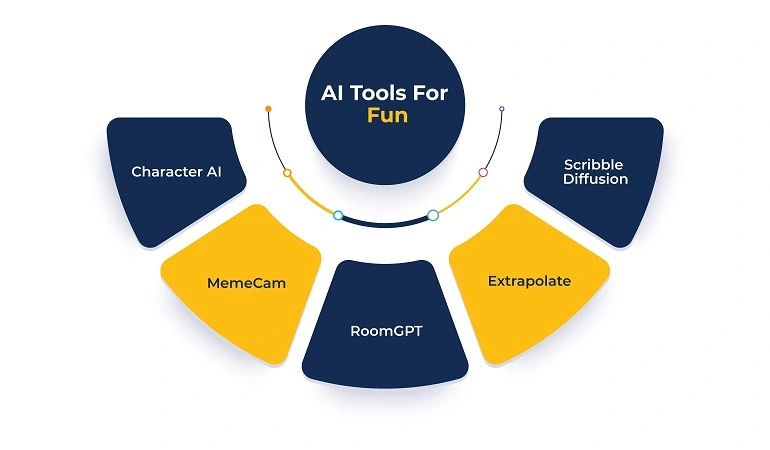
-
Character AI
While chatbots are not sentient and don’t have a personality, Character AI allows users to talk to various personalities. Character AI lets users talk to their favorite characters from Elon Musk and Tony Stark to Saul Goodman and Michael Jackson. But remember that whatever these characters say is made up, not real! You can even create your own characters.
-
MemeCam
If you’re fond of memes, this one’s for you. MemeCam is an AI-powered tool that uses GPT3.5 caption and BLIP image recognition to give your images meme-worthy captions! Isn’t that cool? Upload a photo, and the tool will develop a suitable caption for the picture after reading it. Add some context if you want it to be related to something specific.
-
RoomGPT
By now, it’s quite likely that you’re wondering how “GPT” finds its way into almost everything! Well, that’s how far-reaching AI is, and it is likely to become even more involved in our lives in the coming years. RoomGPT is an AI tool that is revolutionizing interior design.
You only have to give the tool a few pictures of the room you want to redesign. RoomGPT offers you eight different design variations to choose from. But remember, you only get three free generations per day.
-
Extrapolate
Although we could add this one to the list of image manipulation AI tools, it’s more suitable to put it on the list of fun AI tools. Extrapolate shows how users will age over time. It can start by showing you when you were in your teens and continue to your old age. If you’re wondering what you’ll look like in ten or twenty years, give it a shot!
-
Scribble Diffusion
Are you a sketcher? Here’s a tool to turn your sketches into real-life images with a click. And guess what? Your drawings don’t need to be accurate or precise – draw a sketch, give a tiny description, and voila! Scribble Diffusion will turn your sketch into an image in seconds.
That’s a Wrap!
If you’ve come this far, we congratulate you. You’re now armed with the knowledge of the top 45+ AI tools in 2024. Artificial intelligence is set to grow by leaps and bounds. We recommend you watch as tech companies launch newer, more innovative tools in the coming years.
If you want to develop the best AI tool for your business, contact us at [email protected]. We are deeply invested in redefining healthcare through AI-powered innovations.













